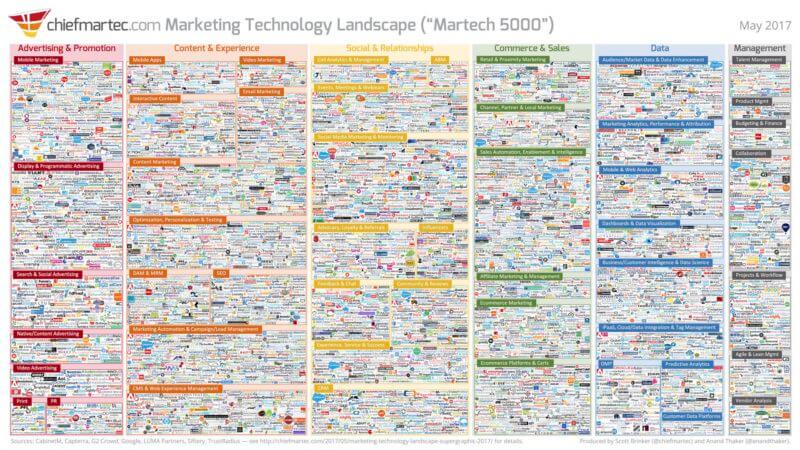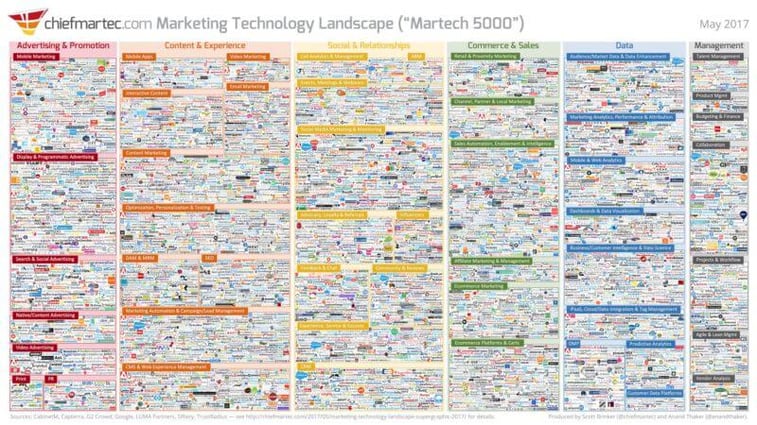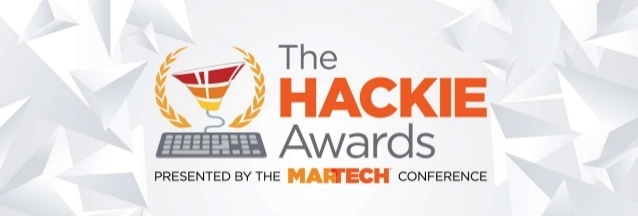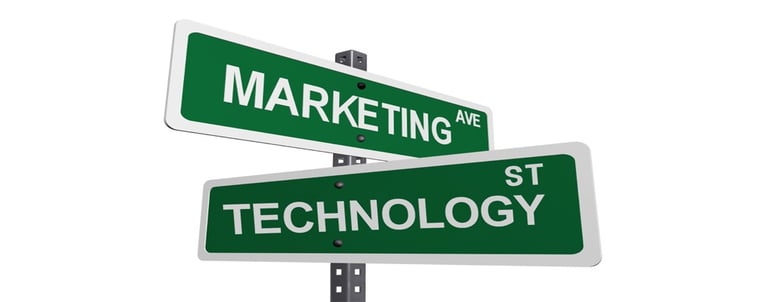

J&C Blog
Find all the latest marketing trends on the J&C Blog.

Find all the latest marketing trends on the J&C Blog.

I recently returned from attending the MarTech Conference in San Francisco. Curated by Scott Brinker of ChiefMartec, it was a three-day firehose of information on marketing and advertising technology. I learned something new in every keynote and breakout session. I have become a martech evangelist.
Presentations had one marketing technology use case after another. I learned how larger enterprises and small businesses use their marketing technology stacks to deliver immersive customer experiences, optimize interactions across the customer journey, increase conversions and break down silos within their organizations. Regardless of industry or customer segment, marketers are using technology to intelligently connect with their customers. Conference presentations covering use cases from the following companies demonstrated this lesson time and again.
Read on to learn some of the key takeaways from the conference.

One of the insights from this year’s conference is how martech helps reach people with increasingly targeted, personalized and contextually relevant customer experiences. This is what consumers say they want. And marketers are answering the call. From Human Centered Design to People Based Marketing, using data-driven technology to put people at the center of marketing was on the minds and lips of most marketers and vendors at this year’s conference.
But martech isn’t just about data; it is about the benefit of using data: reaching people. Presentation after presentation showed how martech was connecting brands and people in ways not previously possible. From customer engagement platforms to chat bots, marketers demonstrated how they used data to optimize human interactions and adapt to changing customer behaviors across marketing channels using a combination of martech tools. Marketers need to choose martech platforms that focus on a unique aspect of each of their customers’ journeys.
Prospects and customers still need to be nurtured and nudged. People today have ever-decreasing attention spans. People do what they can to reduce the effort of making purchase decisions. Martech enables customer communications and experiences to be dynamic, from email and mobile to websites and videos. Marketers have learned that people respond best to content that’s created specifically for them. Now they are trying to deliver.

In 2011, Brinker’s MarTech infographic had 150 logos on it. Last year’s version had 3,600 logos. The 2017 MarTech Infographic has 5,381. The growth in this area is exponential. And it seems to be continuing at an astounding pace.
Marketing technology platforms help both B2B and B2C marketers make marketing operations more efficient and effective. They range in categories such as analysis, attribution, content marketing, customer insights, customer engagement, data management, segmentation and modeling, measurement, optimization, sales enablement and other tasks. They help to create communications and customer experiences that are personalized and relevant.
In the past, these tasks provided results that were approximate and sometimes inaccurate. Developing reports for actionable insights had been time-consuming and labor-intensive. Martech platforms enable marketers to complete chores in milliseconds. Tasks that previously took weeks or months to execute, measure, analyze and react to using traditional business techniques are now automated. Results are based on rich data heretofore unavailable without large investments in staff, time and resources. Modern marketing decision makers are pressed to reduce staff, get more work done quickly, control costs, work with reduced resources and prove the effectiveness of marketing executions. It is a perfect storm for the growth of marketing technology.
There were many overarching themes at this year’s MarTech Conference. There were tracks on customer experience, marketing operations, building martech stacks, emerging and mobile technology, and martech and agile marketing. Each track featured presentations rich with insights and informative content to back claims.
Transformation was a theme through every track. Marketing has gone from a time where there was not access to enough data to make good decisions to a point where the amount of data is doubling annually. Within the next decade, the amount of data is predicted to double every 12 hours!
Data is behind the connected customer experiences that martech platforms help to enable. Martech makes marketing data actionable for attracting, nurturing, engaging, onboarding, activating and optimizing customers.
Because marketing has become more complicated and marketers’ needs are much more specific, no single martech platform has all the answers. Marketers are creating ever larger marketing stacks. While it was hard to integrate multiple platforms just a few years ago, integration with other platforms is now mandatory.
In fact, many martech platforms have already done some of that integration for their customers. Talking with exhibitors, it was often hard to identify what their intellectual property (IP) was and what was that of their partners. With more capabilities being built into platforms, it makes it easier for marketers to reach their goals.
Has martech solved the marketing puzzle? Marketing has become an ever-changing puzzle, where marketers need to change the way that they go to market. Staying the same runs marketers the risk of being passed by competitive brands. Martech can help marketers get over the goal line. It won’t throw the winning pass. Ideas are still the domain of marketers. Marketing is still people to people. Interactions need to have a human touch. So you can’t ignore or forget the basics of providing value and benefits, building trust through transparency or marketing to customers through the channels and ways that they ask you to. You can no longer high-five yesterday’s success and assume that the same strategy and tactics will work tomorrow. You can’t be certain that it is even working today.

Martech has its own awards: The Stackie and Hackie Awards. The Stackie awards are based on a single graphic that illustrates an organization’s marketing stack. This is the collection of marketing tools and technologies that an organization uses to go to market. The Hackies are essays that provide a learning moment, concept or insight based on the intersection of technology, marketing, sales and business.
The best marketing stacks are organized in a way that allows the reader to quickly understand the benefits of each platform that makes up a marketer’s martech stack. Some entries in the Stackie awards were organized around the flow of the customer journey. Others concentrated on specific marketing functions like analytics, engagement, marketing experiments and measurement. To me, it didn’t matter so much who won the competition. The best marketing stacks were those that were designed with marketing users in mind, that had functional capabilities for making marketing programs more efficient and effective, and that were scalable to grow with marketers’ needs.
J&C has more than a dozen platforms in its marketing stack. One reason that I attended this conference was to find new technologies to add to it. I spoke to quite a few platform vendors at the conference. Most are selling directly to clients and enterprises. Some of the larger ones (Adobe, SalesForce, IBM) have partner programs. The majority are focused on selling direct. It’s something that should concern all agencies and marketing services professionals. And it should concern any organization between marketers and customers that can be disintermediated. Which leads me my next takeaway.

Too many martech vendors want to be the single answer to all of a marketer’s problems. If marketers are choosing between buying or building, these vendors want to be the buy alternative. And they don’t want partners, like agencies, standing in the way. The truth is that martech is immensely complicated. There are no one-size-fits-all solutions. The best martech platforms connect with dozens of other platforms. Connecting the dots of martech is the perfect role for agencies who know their client’s needs, are often the architects of their clients’ go-to-market strategies and are advocates for things that make their clients’ marketing better.
Marketing technology platforms cannot just be right for today. Solutions have to be agile and scalable to take advantage of growth opportunities and an ever more dynamic marketplace. Like marketing, martech is evolving. It’s becoming more integrated, which is a good thing. Marketing technology platforms are welcome to work directly with enterprises. Many of my clients have ever-stretched marketing departments, too little time to do their own jobs and no time to address the marketing of tomorrow. This is a great role for marketing agencies want to think beyond creative. Martech vendors would be wise to embrace agencies, not eschew them.

Martech benefits from the tools and techniques of direct marketing. I admit that I have a bias. I can be cited for seeing everything though a direct marketing lens.
Still, modern marketing seems very familiar. It’s built on the same foundation as direct marketing: data. The executions are targeted, personalized, relevant and measured. The experiences reach across thousands of data points and are meant to engage and ultimately generate a response.
It is all in a language vaguely familiar but ever so different. Marketing’s vocabulary has been updated to be more modern and contemporary, just like the myriad of technology platforms that can be used to power marketing today. It’s not direct marketing, it is marketing. It’s not digital business, it is business.
Marketers can’t start thinking about channel and messaging strategies first. As important as mobile is, the world is not mobile first. Marketing’s starting point is customers, prospects, members, subscribers or users first.
Instead of creating a new control, martech platforms allow marketers to continuously optimize audience, copy, keywords, design, offers, calls to action, placement on a page, channel and response.
Marketers still use behavior, transactions, demographics and lifestyle. But new attributes are being added constantly and already include customer intent, sentiment, attitudes, emotions and opinions of a company’s product, brand or service. Personalization? It is now in real time.
Artificial intelligence (AI) is already embedded in search, programmatic buying, predictive analytics, sentiment analysis, product recommendations, image recognition and voice recognition. Using cognitive analytics, AI is helping to identify hidden patterns, find answers and enable better decisions across teams. It is still at a very a nascent stage for most marketing uses. There’s more talk about using artificial Intelligence in marketing than there are case studies. So there is still plenty of time to learn how machine learning, cognitive technology or artificial neural networks can benefit any organization’s marketing.
I came away from MarTech 2017 as a marketing technology evangelist. I will keep evangelizing in blogs, speeches and with clients. One important role for marketing agencies is to help clients connect the dots. Marketing technology has plenty of dots. Many marketing organizations don’t have the time to attend conferences and keep track of all the players. Luckily, Scott Brinker has helped to identity many of the best examples in this growing field. Others are left with the task of helping make sense of it for marketing organizations. I will keep doing my part.
Sign up for the J&C marketing newsletter to discover best practices for integrating modern marketing technologies and strategies to drive real business results.

Topics: Digital Marketing
303 E Wacker Drive, Suite 2030
Chicago, IL 60601
Phone: 312-894-3000
Fax: 312-894-3005